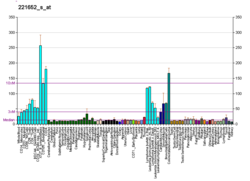| INTS13 |
|---|
|
| Identifiers |
|---|
| Aliases | INTS13, C12orf11, GCT1, Mat89Bb, NET48, SPATA30, ASUN, asunder, spermatogenesis regulator, integrator complex subunit 13 |
|---|
| External IDs | OMIM: 615079; MGI: 1918427; HomoloGene: 10043; GeneCards: INTS13; OMA:INTS13 - orthologs |
|---|
| Gene location (Human) |
|---|
 | | Chr. | Chromosome 12 (human)[1] |
|---|
| | Band | 12p11.23 | Start | 26,905,181 bp[1] |
|---|
| End | 26,938,326 bp[1] |
|---|
|
| Gene location (Mouse) |
|---|
 | | Chr. | Chromosome 6 (mouse)[2] |
|---|
| | Band | 6|6 G3 | Start | 146,549,632 bp[2] |
|---|
| End | 146,577,835 bp[2] |
|---|
|
| RNA expression pattern |
|---|
| Bgee | | Human | Mouse (ortholog) |
|---|
| Top expressed in | - secondary oocyte
- C1 segment
- epithelium of nasopharynx
- tibia
- biceps brachii
- germinal epithelium
- Skeletal muscle tissue of biceps brachii
- gingival epithelium
- gonad
- retinal pigment epithelium
|
| | Top expressed in | - otic placode
- saccule
- otic vesicle
- neural layer of retina
- tail of embryo
- genital tubercle
- spermatocyte
- epiblast
- thymus
- ventricular zone
|
| | More reference expression data |
|
|---|
| BioGPS |  | | More reference expression data |
|
|---|
|
| Gene ontology |
|---|
| Molecular function | | | Cellular component | - cytoplasm
- nucleoplasm
- nucleus
| | Biological process | - centrosome localization
- regulation of fertilization
- flagellated sperm motility
- mitotic spindle organization
- cell cycle
- protein localization to nuclear envelope
- regulation of mitotic cell cycle
- cell division
- snRNA transcription by RNA polymerase II
| | Sources:Amigo / QuickGO |
|
| Orthologs |
|---|
| Species | Human | Mouse |
|---|
| Entrez | | |
|---|
| Ensembl | | |
|---|
| UniProt | | |
|---|
| RefSeq (mRNA) | | |
|---|
| RefSeq (protein) | | |
|---|
NP_620096
NP_001349035
NP_001349036
NP_001349037 |
|
|---|
| Location (UCSC) | Chr 12: 26.91 – 26.94 Mb | Chr 6: 146.55 – 146.58 Mb |
|---|
| PubMed search | [3] | [4] |
|---|
|
| Wikidata |
| View/Edit Human | View/Edit Mouse |
|



















